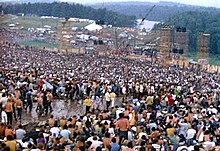User:1960movements
Social and Political Movements of The 1960s
[edit]Counter Culture/ Social Revolution
[edit]In the 1960's the counterculture lifestyle that had formed by the young people in the US and ended up taking over most of the western world. It was a reaction against the war, materialism, and social conformity and strays away from the previous conservative norms that once were and becomes a period of liberation and change. New cinema, political views, clothing, and music had emerged.

Rock and roll was a huge part of the movement, with names like Bob Dylan, Jimi Hendrix, Janis Joplin, the Beatles, the Rolling Stones, and the Grateful Dead changing the face of music. Counterculture was a time of creativity, experimentation, freedom and acceptance. The hippie and bohemian lifestyles were wildly popular bringing drugs, sex, art, and social activism to a all time high. The counterculture movement brought a new demand for rights for women, minorities, and homosexuals. Many revolted against the government, authorities, and disrupted the order of the way things has been previously.

Anti-War Movement
[edit]The anti-war movement originally started as the 1950's peace movement, which was highly influenced by the American Communist Parties. By the 1960's it outgrew its former self and became a broad based massive movement centered on college Universities and it was able to have extremely strong influences of the US government. In the 1960's America was heavily involved in the Vietnam War. It was the first war to be publicly televised and showed the horrors of war for everyone to see. Americans at first were only disgusted at the destruction, but after a few years they started to doubt if the war in Vietnam was necessary. The extremely high casualties on both sides infuriated US citizens and that unrest fueled the anti-war movement. A famous song came out of this time period and shines out as a great example of the American's citizens feelings towards the war. This artist name is Edwin Starr who made the song called war which describes the people view of the war in Vietnam.
Civil Rights Movement
[edit]The African-American Civil Rights Movement was a movement that originated around 1955 and continued until the late 60s. Even though there was a violent and nonviolent movement led by Malcolm X and Martin Luther King Jr., the main goal behind the movement was to end racial segregation and discrimination against black Americans. Throughout the years of 1955 to 1968, nonviolent civil rights activists showed acts of protest which often created altercations between government authorities. Examples of nonviolent civil rebellion included boycotts, sit-ins and marches, such as the Montgomery Bus Boycott in Alabama; the Greensboro sit-ins in North Carolina; and the Selma to Montgomery marches(all pictured below). The violent protests, strongly initiated by Malcolm X, included aligning blacks with organizations that believed in the right of self-defense actions.
While the leaders of the overall movement ranged from ministers and pastors, like Malcolm X and Martin Luther King, Jr., the president of the United States, John F. Kennedy, was also seen as a major leader in the Civil Rights Movement, as well as his successor, Lyndon B. Johnson. Some well-known events caused a lot of news coverage throughout the movement due to the high profile leaders and sensitivity on the subject in Congress from all sides. On August 28, 1963, thousands of protesters marched and gathered in front of the Lincoln Memorial, where Martin Luther King Jr. then delivered his famous “I Have a Dream” speech. President Kennedy attempted to pass a new civil rights legislation through Congress months before King's dream speech. Unfortunately, before the bill could be passed, Kennedy was assassinated on November 22, 1963. Soon after Kennedy’s death, President Lyndon B Johnson signed and passed the Civil Rights Act of 1964, which banned discrimination at the workplace and other facilities that served the general public. Other achievements that came from the movement were the passing of the Voting Rights Act of 1965, which restored and protected voting rights, and the Fair Housing Act of 1968, which banned discrimination in the sale or rental of housing.
Hispanic and Chicano Movement
[edit]Mexican American are among Hispanics in the US. who fought end racial discrimination and socioeconomic disparity. The Chicano movement addressed what it perceived to be negative ethnic stereotypes of mexicans in mass media and the american consciousness. The Chicano movement also addressed discrimination in public and private institutions. The most prominent civil rights organization in the mexican american community, the Mexican American Legal Defense and Educational Fund (MALDEF) was founded in 1968. Puertoricans in the US. mainland fought against racism, police brutality and socioeconomic problems affecting 3 million Puertoricans residing in 50 states, the main concentration was in New York City. In the 1960's and the following 1970's, Hispanic American culture was on the rebound like ethnic music, foods, culture and identity both became popular and assimilated into the American mainstream.
Citations
[edit]- ^ http://en.wiki.x.io/wiki/1960s#Social_and_political_movements
- ^ http://en.wiki.x.io/wiki/Counterculture_of_the_1960s
- ^ http://en.wiki.x.io/wiki/Opposition_to_the_U.S._involvement_in_the_Vietnam_War
- ^ http://en.wiki.x.io/wiki/Civil_Rights_Movement
- ^ http://en.wiki.x.io/wiki/1960s#Hispanic_and_Chicano_Movement
